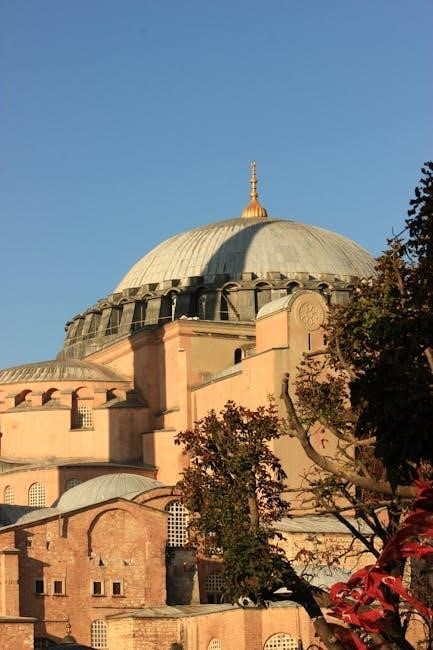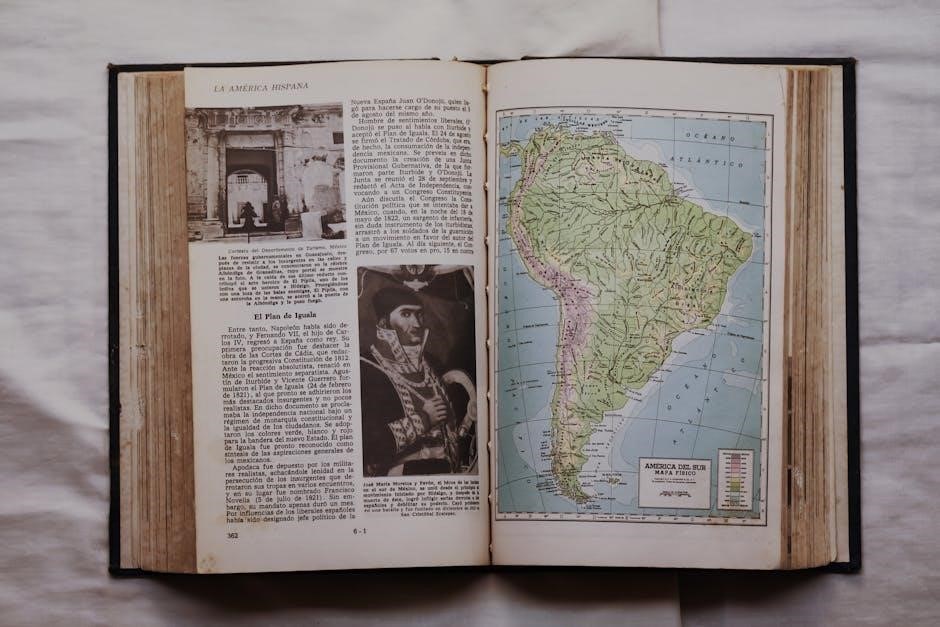The HMH World History Textbook, published by Houghton Mifflin Harcourt, offers a comprehensive exploration of global historical events and cultural developments, fostering critical thinking and connections between past and present.
1.1 Overview of HMH Publishing
Houghton Mifflin Harcourt (HMH) is a renowned educational publishing company dedicated to delivering high-quality learning materials. Specializing in textbooks, digital resources, and educational programs, HMH supports teachers and students worldwide. Their publications, including the World History textbook, are designed to engage students and promote deeper understanding of historical events. HMH integrates innovative technologies, such as interactive digital formats and multimedia, to enhance learning experiences. With partnerships like the History Channel and availability in multiple languages, HMH ensures accessibility and inclusivity for diverse learners, making it a trusted name in education.
1.2 Importance of World History Education
World history education is essential for fostering global awareness and cultural understanding. It equips students with the ability to analyze historical events, recognize patterns, and appreciate diverse perspectives. By studying world history, students develop critical thinking skills, enabling them to connect past events to contemporary issues. This knowledge promotes empathy, cultural competence, and informed citizenship. The HMH World History Textbook emphasizes these values, providing a structured approach to help students navigate the complexities of global interactions and their impact on modern society. Such education prepares learners to engage thoughtfully in an increasingly interconnected world.
1.3 Structure of the HMH World History Textbook

The HMH World History Textbook is organized into 12 chapters, each focusing on key historical periods and regions, from “The First Humans” to “Renaissance and Reformation.” The textbook integrates primary sources, multimedia, and critical thinking exercises to enhance learning. Digital access provides interactive features, while supplementary materials like reading guides and partnerships with educational organizations enrich the curriculum. The structure ensures a balanced mix of content, engagement, and analysis, making it a versatile tool for both teachers and students. This design supports a deep understanding of global history and its relevance to modern times.

Key Features of the HMH World History Textbook
The HMH World History Textbook features comprehensive historical coverage, interactive digital formats, primary sources, multimedia, and critical thinking exercises, available in multiple languages for diverse learning needs.
2.1 Comprehensive Coverage of Historical Periods
The HMH World History Textbook provides a detailed exploration of historical periods, from ancient civilizations to modern times. It covers key events, cultural developments, and global connections, ensuring a well-rounded understanding. Chapters are organized chronologically, starting with early humans and progressing through eras like Western Asia, Egypt, India, China, and the Americas. The textbook also delves into the rise of major religions, empires, and revolutions, offering insights into their impact on the modern world. Primary sources and multimedia elements enhance the learning experience, making history engaging and accessible for students.
2.2 Interactive Digital Format
The HMH World History Textbook is available in an interactive digital format, enhancing student engagement with history. The digital version includes page navigation, allowing seamless movement between sections. Students can access the textbook offline via a downloadable app, ensuring learning continues anywhere. The format also supports multiple languages, with Spanish versions available as PDFs. These features make the textbook accessible and flexible, catering to diverse learning needs and preferences. The interactive elements and offline access promote independent study and deeper exploration of historical content.
2.3 Integration of Primary Sources and Multimedia
The HMH World History Textbook seamlessly integrates primary sources and multimedia to enrich the learning experience. Students engage with historical documents, images, and videos, providing authentic context to key events. Multimedia elements, such as audio clips and interactive maps, enhance understanding and make history more accessible. Partnerships with organizations like the History Channel add depth, offering real-world connections. These resources help students analyze historical events critically and develop a deeper appreciation for diverse cultures and perspectives. The combination of primary sources and multimedia creates a dynamic, immersive learning environment that fosters academic success and intellectual curiosity.
2.4 Critical Thinking and Analytical Exercises
The HMH World History Textbook incorporates critical thinking and analytical exercises to help students engage deeply with historical content. These exercises encourage students to analyze primary sources, evaluate evidence, and draw meaningful conclusions. Structured activities guide learners in identifying patterns, causes, and effects of historical events. The textbook also includes reflective questions and debates to foster intellectual curiosity and problem-solving skills. By emphasizing analytical thinking, the HMH World History Textbook prepares students to approach complex historical themes with confidence and intellectual rigor, equipping them with essential skills for academic and real-world applications.
Chapters and Content Overview
The HMH World History Textbook is organized into 12 chapters, spanning from “The First Humans” to “Renaissance and Reformation,” providing a detailed exploration of global historical periods and civilizations.
3.1 Chapter 1: The First Humans
Chapter 1 explores the emergence of early humans, tracing their development from hominids to modern humans. It covers migration patterns, tool development, and the rise of complex societies, providing insights into human origins and early cultural advancements.
3.2 Chapter 2: Western Asia and Egypt
Chapter 2 delves into the rise of civilizations in Western Asia and Egypt, highlighting their cultural, social, and political achievements. It explores Mesopotamia, often called the “cradle of civilization,” and the Nile River Valley, emphasizing advancements in agriculture, governance, and architecture. The chapter also examines the development of writing systems, religious practices, and trade networks, showcasing the enduring legacy of these ancient societies. Through primary sources and multimedia, students gain insights into the daily lives and contributions of these early civilizations, fostering a deeper understanding of their impact on modern society.
3.3 Chapter 3: India and China
Chapter 3 explores the ancient civilizations of India and China, focusing on their cultural, philosophical, and technological advancements. It discusses the Indus Valley Civilization, the Vedic Period, and the development of Hinduism and Buddhism in India. In China, the chapter highlights the Shang and Zhou Dynasties, the Mandate of Heaven, and the contributions of Confucianism and Taoism. The text also covers early innovations, such as India’s decimal system and China’s Great Wall and compass, illustrating their enduring legacies in global history and culture.

3.4 Chapter 4: Ancient Greece
Chapter 4 delves into Ancient Greece, a cornerstone of Western civilization. It explores the Golden Age of Athens, where democracy, theater, and philosophy flourished. Key figures like Socrates, Plato, and Aristotle are highlighted for their intellectual contributions. The chapter also covers the Persian and Peloponnesian Wars, showcasing Greece’s resilience and strategic prowess. Additionally, it examines the cultural achievements, such as the development of the Olympic Games and the iconic architecture of the Parthenon. This section underscores the enduring legacy of Ancient Greece in shaping modern political, philosophical, and cultural ideals.
3.5 Chapter 5: Rome and the Rise of Christianity
Chapter 5 examines the rise and fall of the Roman Empire, emphasizing its political, social, and cultural achievements. It explores the transition from the Roman Republic to the Empire, the Pax Romana, and the legal advancements of Roman law. The chapter also delves into the emergence of Christianity, tracing its origins from the life of Jesus Christ to its spread across the empire. Key events, such as the crucifixion, the apostolic missions, and the Edict of Milan, are highlighted. The section concludes with the legacy of Rome and Christianity, shaping the foundation of modern Western civilization and religious practices.
3.6 Chapter 6: The World of Islam
Chapter 6 explores the rise and spread of Islam, beginning with the life of Muhammad and the revelation of the Quran. It examines the Five Pillars of Islam and the expansion of Islamic territories. The chapter highlights key events, such as the Hijra and the Rashidun Caliphate, while discussing Islamic law, science, and culture. The impact of trade and cultural exchange within the Islamic Golden Age is emphasized, showcasing advancements in mathematics, medicine, and philosophy. The section also addresses the diversity of Islamic societies and their enduring influence on global history and modern cultures.
3.7 Chapter 7: Early African Civilizations
Chapter 7 delves into the origins and development of early African civilizations, highlighting their cultural, economic, and technological advancements. It explores the rise of ancient kingdoms such as Nubia, Axum, and the Kingdom of Kongo, emphasizing their contributions to global trade and cultural exchange. The chapter discusses the significance of African innovations, including agriculture, metallurgy, and architectural achievements. It also examines the role of oral traditions and the spread of ideas across the continent. This section underscores the diversity and richness of African societies, showcasing their enduring impact on world history and modern cultures.
3.8 Chapter 8: The Asian World
Chapter 8 explores the rich cultural and historical tapestry of the Asian world, focusing on the rise of major civilizations in China, India, and Japan. It examines the philosophical foundations of Confucianism, Buddhism, and Hinduism, and their enduring influence on Asian societies. The chapter also delves into the political and economic developments of empires such as the Qin, Han, and Gupta dynasties, highlighting their contributions to science, art, and technology. Additionally, it discusses the significance of the Silk Road and maritime trade networks in fostering cultural exchange and economic prosperity across the region, shaping the modern Asian landscape.
3.9 Chapter 9: Emerging Europe and the Byzantine Empire
Chapter 9 delves into the transformation of Europe after the fall of the Roman Empire, focusing on the rise of the Byzantine Empire and its cultural, religious, and political developments. It explores the significance of Constantinople as a center of trade and learning, as well as the spread of Christianity throughout Europe. The chapter also examines the challenges faced by the Byzantine Empire, including invasions and internal conflicts, while highlighting its enduring legacy in shaping medieval Europe’s identity and institutions. This section provides a detailed look at the transition from antiquity to the medieval period.
3.10 Chapter 10: Europe in the Middle Ages
Chapter 10 explores the social, political, and economic transformations of Europe during the Middle Ages. It examines the rise of feudalism, the role of the Catholic Church, and the impact of the Crusades. The chapter highlights the development of medieval kingdoms, the growth of trade, and the emergence of towns. It also discusses the cultural advancements, such as the construction of cathedrals and the preservation of knowledge in monasteries. This section provides insight into how the Middle Ages laid the foundation for Europe’s transition to the Renaissance and beyond, shaping its identity and institutions.
3.11 Chapter 11: The Americas
Chapter 11 delves into the history of the Americas, tracing the migration of indigenous peoples and the development of pre-Columbian civilizations. It explores the Aztec and Inca empires, highlighting their cultural, political, and economic achievements. The chapter also examines the impact of European exploration and colonization, including the Columbian Exchange and its far-reaching consequences. Additionally, it discusses the diverse Native American cultures and their responses to European settlement. This section provides a rich understanding of the Americas’ complex past, emphasizing the interplay between indigenous traditions and external influences that shaped the region’s history.

3.12 Chapter 12: Renaissance and Reformation
Chapter 12 explores the transformative periods of the Renaissance and Reformation, spanning the 14th to 17th centuries. The Renaissance is highlighted for its cultural and artistic revival, emphasizing humanism and iconic figures like Leonardo da Vinci. The Reformation, sparked by Martin Luther and John Calvin, is examined for its religious and societal impact, leading to the rise of Protestantism and religious divisions in Europe. This chapter underscores the causes and effects of these movements, illustrating how they reshaped European society, politics, and culture, laying the groundwork for modern Western civilization.
Digital Access and Resources
The HMH World History Textbook offers digital access, enabling students to engage with interactive content, primary sources, and multimedia resources. Supplementary materials are available online, enhancing learning experiences.
4.1 How to Access the Digital Version
To access the digital version of the HMH World History Textbook, visit http://hmh.pisd.edu and log in with your unique school credentials. Ensure you exclude “mypisd.net” when logging in, as if accessing from a school computer. The digital format offers interactive features, primary sources, and multimedia resources. Students can download individual chapters or the full textbook in PDF format for offline access. This convenient access allows for flexible learning, enabling students to study anytime, anywhere, while engaging with the comprehensive content provided by HMH.
4.2 Benefits of the Digital Format
The digital version of the HMH World History Textbook offers numerous advantages, including interactive features, multimedia resources, and easy access. Students can engage with primary sources, videos, and critical thinking exercises, enhancing their learning experience. The digital format allows for anytime, anywhere access, making it ideal for flexible study schedules. Additionally, the ability to download chapters or the full textbook in PDF format ensures that students can study offline, while the interactive elements promote deeper understanding and retention of historical content. This modern approach to education supports both teachers and students in achieving academic success.
4.3 Supplementary Online Materials
The HMH World History Textbook is complemented by a wealth of supplementary online materials, including reading guides, interactive activities, and multimedia resources. These materials are designed to enhance student engagement and deepen understanding of historical concepts. Partnerships with educational organizations, such as the National Civil Rights Museum, further enrich the learning experience. Additionally, the textbook is available in multiple languages, including Spanish, ensuring accessibility for a diverse range of learners. These resources, accessible via the HMH platform, provide teachers and students with a robust toolkit to explore world history in a dynamic and comprehensive manner.
Teaching and Learning Tools

The HMH World History Textbook provides robust teaching and learning tools, including teacher resources, lesson plans, and student engagement strategies, to enhance educational experiences and outcomes effectively.
5.1 Teacher Resources and Lesson Plans
The HMH World History Textbook offers extensive teacher resources, including detailed lesson plans, background information, and activities tailored to various learning styles. These resources are designed to help educators effectively deliver historical content, ensuring students grasp key concepts. Additionally, the textbook provides supplementary materials such as unit overviews, primary source analysis, and interactive exercises. Teachers can access these tools through the HMH platform, enabling them to create engaging and structured lessons. The resources also align with educational standards, making it easier for teachers to track student progress and adapt instruction to meet diverse classroom needs.
5.2 Student Engagement Strategies
The HMH World History Textbook incorporates innovative strategies to engage students, fostering active participation and deeper understanding. Interactive digital tools, such as timelines and multimedia content, captivate learners and make history relatable. Primary sources and critical thinking exercises encourage students to analyze historical events from multiple perspectives. Collaborative activities and real-world connections further enhance engagement, helping students see the relevance of history in their lives. These strategies promote a dynamic learning environment, ensuring students are not just passive readers but active explorers of the past.
5.3 Assessment and Evaluation Tools
The HMH World History Textbook provides robust assessment and evaluation tools to measure student understanding and progress. Interactive quizzes, chapter reviews, and critical thinking exercises help gauge comprehension. The digital format includes progress-tracking features, allowing teachers to monitor student performance in real time. Customizable tests and printable worksheets offer flexibility for traditional assessments. Additionally, the textbook integrates with online platforms for seamless grading and feedback, ensuring a comprehensive approach to evaluation. These tools empower educators to identify areas where students may need additional support, fostering a more personalized and effective learning experience.

Historical Periods and Themes
The HMH World History Textbook explores ancient civilizations, medieval societies, and modern developments, emphasizing cultural exchange and global connections that shaped human history and its relevance today.
6.1 Ancient Civilizations
The HMH World History Textbook dedicates extensive coverage to ancient civilizations, exploring their cultural, social, and political developments. Chapters 1 through 6 delve into the origins of humanity, Mesopotamia, Egypt, the Indus Valley, China, and Mesoamerica. These sections highlight key contributions such as writing systems, governance, and technological advancements. The textbook incorporates primary sources, images, and multimedia to engage students in understanding the rise and fall of these civilizations. By examining these early societies, students gain insights into the foundations of modern cultures and global connections. The content is structured to promote critical thinking about the legacy of ancient worlds.
6.2 Medieval and Early Modern History
The HMH World History Textbook thoroughly explores the medieval and early modern periods, spanning the Middle Ages to the Renaissance. Chapters 9-12 examine the rise of feudalism, the influence of the Byzantine Empire, and the cultural transformations of the Renaissance. The textbook also delves into the Reformation, global explorations, and the emergence of nation-states. Primary sources, such as medieval manuscripts and historical artifacts, are integrated to provide students with a vivid understanding of these transformative eras. Interactive features and critical thinking exercises help students analyze the social, political, and religious changes that shaped this pivotal period in world history.
6.3 Modern World History
The HMH World History Textbook dedicates significant attention to modern world history, covering key events from the 18th century to the present. Chapters explore revolutions, industrialization, imperialism, and global conflicts, including World War I and II. The textbook also examines the Cold War, decolonization, and contemporary issues like globalization and technological advancements. Primary sources, such as speeches and treaties, provide context, while multimedia elements and critical thinking exercises help students analyze the complexities of modern historical developments and their lasting impact on the world today.
6.4 Global Connections and Cultural Exchange
The HMH World History Textbook emphasizes the significance of global connections and cultural exchange in shaping societies. It explores how trade networks, such as the Silk Road, facilitated the exchange of goods, ideas, and cultures between civilizations. The textbook also highlights the impact of exploration, colonization, and migration on cultural diversity. Through primary sources and multimedia, students learn about the Columbian Exchange, the spread of religions, and the modern effects of globalization. These resources help students understand how interconnectedness has influenced historical and contemporary societies, fostering cross-cultural understanding and appreciation.

Additional Resources and Partnerships
The HMH World History Textbook offers additional resources through partnerships with educational organizations, availability in multiple languages, and supplementary online materials for enhanced learning.
7.1 HMH Social Studies World History Reading Guides
The HMH Social Studies World History Reading Guides provide comprehensive unit-by-unit resources for grades 8-13, offering detailed readings and study materials. Designed to support both teachers and students, these guides align with the World History curriculum, ensuring a structured approach to learning. Available in PDF format, they can be easily accessed online, allowing for flexible study options. The guides cover key historical periods, from ancient civilizations to modern global connections, and include interactive elements to enhance engagement. They are an essential tool for fostering historical literacy and critical thinking skills, making them a valuable supplement to the HMH World History Textbook.
7.2 Partnerships with Educational Organizations

HMH has established partnerships with prominent educational organizations to enrich the learning experience. Collaborations with entities like the History Channel, Checkology, and the National Civil Rights Museum provide students with authentic historical content and interactive resources. These partnerships enhance the textbook’s educational value by offering real-world connections and immersive learning opportunities. Teachers and students benefit from access to exclusive materials, such as documentaries, primary sources, and multimedia tools, which foster a deeper understanding of historical events and cultural contexts. These alliances underscore HMH’s commitment to delivering high-quality, engaging educational resources.
7.3 Availability in Multiple Languages
The HMH World History Textbook is available in multiple languages, including English and Spanish, to cater to diverse student populations. While the English version offers interactive digital features, the Spanish edition is provided in PDF format, ensuring accessibility for Spanish-speaking learners. This bilingual availability reflects HMH’s commitment to inclusivity and meeting the needs of a global student body. By offering the textbook in multiple languages, HMH promotes equitable access to high-quality educational resources, helping students from various linguistic backgrounds to engage with world history content effectively.

Conclusion
The HMH World History Textbook is a vital educational resource, offering comprehensive, engaging content that supports both educators and students in understanding global historical developments effectively.
8.1 The Role of HMH World History Textbook in Education
The HMH World History Textbook plays a pivotal role in education by providing a comprehensive and engaging resource for students and educators. It offers a detailed exploration of global historical events, cultural developments, and their impact on modern society. The textbook is designed to foster critical thinking, analytical skills, and a deeper understanding of historical connections. With its interactive digital format, primary sources, and multimedia integration, it caters to diverse learning styles. Additionally, its availability in multiple formats, including PDF, ensures accessibility for all learners, making it an essential tool for effective history education.
8.2 Future of World History Education with HMH
The future of world history education with HMH is poised for innovation and accessibility. By leveraging digital tools, interactive content, and partnerships with educational organizations, HMH continues to enhance learning experiences. The integration of primary sources, multimedia, and critical thinking exercises prepares students for a globalized world. With resources available in multiple languages and formats, including PDF, HMH ensures inclusivity and adaptability. Its commitment to evolving with educational needs guarantees that students will engage deeply with history, fostering a brighter, more informed future for all learners.